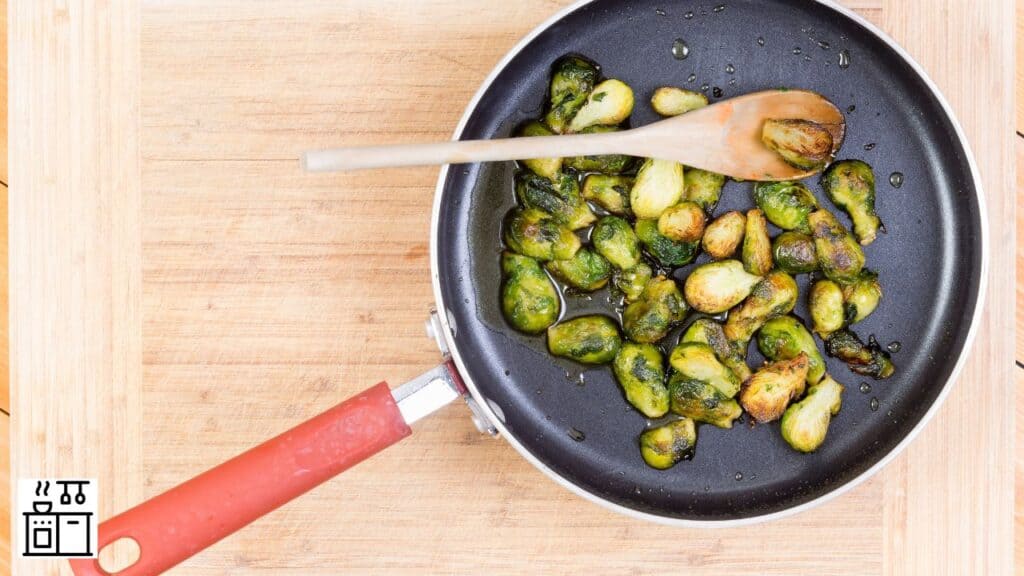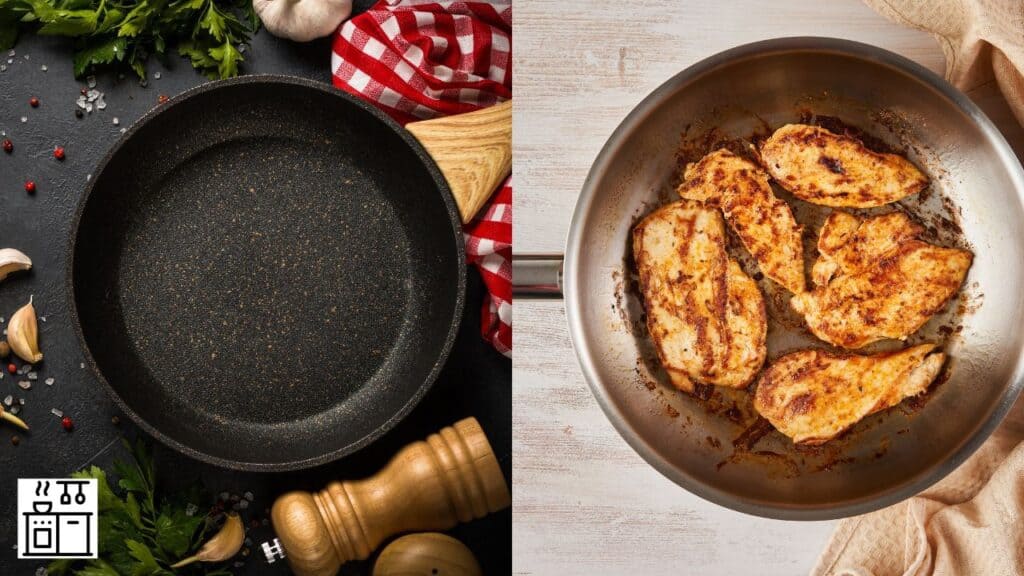When choosing pans for cooking, various factors like the ease of handling, how well they conduct heat, and even the price point are selection criteria.
Since non-stick and stainless steel pans are easily available, let’s compare them and learn about their differences.
- 8 Differences Between Non-Stick and Stainless Steel Pans
- 1. The construction is different.
- 2. Stainless steel pans aren't naturally non-sticky.
- 3. Stainless steel pans are generally oven-safe.
- 4. Non-stick pans are good for cooking delicate ingredients.
- 5. It's easier to clean non-stick pans.
- 6. Stainless steel pans are better for making sauces and gravy.
- 7. Stainless steel pans can handle rough use.
- 8. Stainless steel pans are free from the potential risks of non-stick pans.
8 Differences Between Non-Stick and Stainless Steel Pans
Different pans are better suited for different tasks.
Though non-stick and stainless steel pans are interchangeable for some tasks, they mostly serve different purposes in the kitchen.
Here are the main differences between non-stick pans and stainless steel pans.
1. The construction is different.
Non-stick and stainless steel pans are entirely different in their construction.
Stainless steel pans are made from an alloy of iron and carbon.
The thickness of these pans will differ based on how many layers of alloy are joined together to form the base.
Nevertheless, all stainless steel pans have the same alloy in the body.
However, the handle may be stainless steel, wood, or synthetic materials.
Traditional non-stick pans are made of cast iron or carbon steel. Both are alloys of iron and carbon.
However, the amount of carbon in each of the alloys differs.
These pans acquire their non-stick properties through seasoning.
Meanwhile, modern non-stick pans have a metallic base and a non-stick layer.
This layer can be Teflon, PTFE, or an enameled or ceramic layer.
Non-stick pans with Teflon or PTFE coating are prone to scratches.
They lose their non-stick properties if the top layer gets scratched.
The non-stick properties of enameled non-stick pans and ceramic pans reduce with use as the coating undergoes wear and tear.
2. Stainless steel pans aren’t naturally non-sticky.
Stainless steel is widely used for cooking because it has many attractive properties.
It conducts heat evenly, is lightweight and easy to handle, and is durable. However, it’s not non-sticky.
Seasoning the pan will not help it develop a layer of patina that forms on cast iron and carbon steel pans.
Hence, food sticks to the surface of the pan. You must use enough oil or cooking spray to prevent food from sticking.
However, food always glides off the surface of a non-stick pan. This reduces the need for oil during cooking.
Teflon-coated and enamel or ceramic pans don’t require seasoning.
Cast iron and carbon steel pans must be seasoned with oil before first use.
This creates a layer of seasoning or ‘patina’ that makes the surface smooth and non-sticky.
The patina improves with continuous use, making it easier to remove food from the surface.
3. Stainless steel pans are generally oven-safe.
It’s always handy to have cookware that can directly go from the stovetop to the oven.
This makes cooking and cleaning much easier.
Stainless steel pans are generally oven-safe, and you can directly transfer them from the stove to the oven.
The only exception is if the handle isn’t oven-safe but is made of wood or plastic.
Not all non-stick pans are oven-safe. It depends on the material used for construction.
For instance, cast iron and carbon steel pans are generally oven-safe.
Once again, you must check that the handle is also oven-safe before placing them in the oven.
However, non-stick pans with PTFE or Teflon coatings are generally not oven-safe.
Teflon is sensitive to high temperatures, and it breaks down and releases chemical fumes when heated too much.
This makes it unsafe to cook food in it.
High heat will also make the Teflon coating deteriorate and lose its non-stick properties.
If a stainless steel pan has an oven-safe handle, you can use it for oven cooking without hesitation.
However, refer to the manufacturer’s instructions to decide if a non-stick pan is safe for oven use.
Manufacturers will usually place the oven-safe symbol on the handle or base of the pan.
4. Non-stick pans are good for cooking delicate ingredients.
One of the most important factors to consider when choosing pans is what you plan to use them for.
Stainless steel pans are suitable for cooking many ingredients.
However, they aren’t the best choice for cooking delicate ingredients like eggs or certain types of fish.
Food tends to stick to their surface.
So you will not be able to remove items like fried eggs or crepes from these pans without breaking them.
You may also end up using more oil than necessary to remove items from their surface.
Non-stick pans don’t have such problems. Food easily glides off the non-stick surface.
Hence they are perfect for cooking eggs, pancakes, and delicate fish.
5. It’s easier to clean non-stick pans.

Since food doesn’t stick to the surface of non-stick pans, they are easy to clean.
Most of the time, you can just wipe the surface to get rid of any residual food or oil.
You can also clean the pan with mild dishwashing soap and water.
It’s not as easy to clean stainless steel pans. The surface is sticky.
Hence, some of the food cooked in it will remain on the surface.
Liquid-based dishes are generally easy to remove from these pans.
Even so, you may have to soak and scrub harder to get all the food off the pan.
However, most stainless steel pans are dishwasher-safe.
So the dishwasher will take care of all the scrubbing.
Meanwhile, you can’t place most types of non-stick pans in the dishwasher.
The high temperature and long exposure to moisture can damage their non-stick layer.
6. Stainless steel pans are better for making sauces and gravy.
A non-stick pan is clearly the better choice for frying.
However, stainless steel pans are better for making sauces and gravy.
In a non-stick pan, the food doesn’t stick to the base.
So there will be no seared or charred bits that add extra flavor to the gravy.
When you cook ingredients in a stainless steel pan, some of the food naturally sticks to the base.
All the juices released by the ingredients will also stick to the pan and remain there.
You can deglaze the pan with liquid.
This adds more depth of flavor to the dish. Similarly, stainless steel pans are also good for browning food.
7. Stainless steel pans can handle rough use.
Stainless steel pans are generally more versatile than non-stick pans.
The metal base is inert. It’s not prone to dents or scratches.
So you can use any spatula or spoon to stir ingredients in the pan.
The same goes for cleaning also. Harsh scrubbers and detergents can make the pans lose their original luster.
However, the surface doesn’t erode, and you can safely cook in them.
Cast iron and carbon steel pans are non-stick because of the seasoning they develop over time.
To retain their non-stick properties, you should be careful not to dislodge this layer of seasoning.
The seasoning isn’t affected by metallic spatulas and spoons. However, harsh abrasive scourers can tear it.
You will have to season the pan again to restore its non-stick properties.
Non-stick pans with PTFE and Teflon coatings are very delicate.
Hence, you shouldn’t use metallic spoons to stir ingredients in these pans.
They can scratch the surface and tear the non-stick coating.
It will make the pan lose its non-stick properties.
Additionally, the exposed chemical layer can also release toxic fumes that contaminate food.
You should use only wooden or silicone spoons with non-stick cookware.
Similarly, you should also use gentle cleaners and scouring pads that will not scratch the surface during cleaning.
8. Stainless steel pans are free from the potential risks of non-stick pans.
Stainless steel is inert. It doesn’t react with food. Hence, it’s one of the safest materials to use for cooking.
However, the same can’t be said of non-stick pans.
Regardless of whether you are looking at cast iron and carbon steel pans or modern non-stick pans with chemical coatings, they present a few risks.
Cast iron and carbon steel pans are suitable for cooking most ingredients. However, there is iron in the alloy.
Iron is a reactive metal, and it reacts with acidic ingredients.
Cooking dishes containing acidic ingredients like vinegar and tomato will cause chemical reactions.
These can damage the surface of the pan.
So it’s not good to retain food with acidic components in these pans for too long.
You should immediately transfer such dishes to another inert container and avoid storing them in iron-based non-stick cookware.
Non-stick cookware with chemical coatings like Teflon and PTFE has been linked to various problems.
The non-stick layer is usually delicate and prone to scratches and dents.
If the layer peels off, bits of it end up in the food and contaminate it.
Another likely problem is that scratched non-stick pans can release toxic fumes during cooking that are risky.

